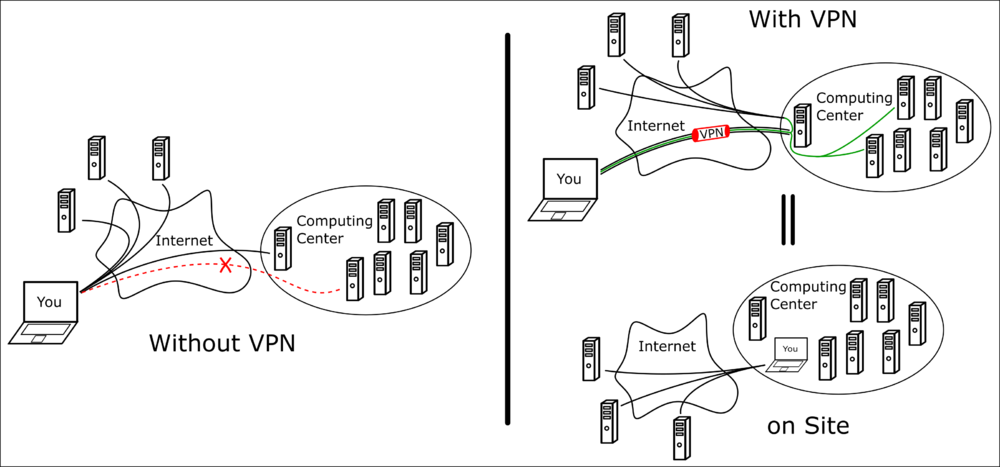Difference between revisions of "VPN"
(→�) |
|||
| Line 15: | Line 15: | ||
As well as: | As well as: | ||
| − | * For every other entity in the internet your connection seems to be coming from the computing center, which might be | + | * For every other entity in the internet your connection seems to be coming from the computing center, which might be helpful for e.g. accessing library articles or materials restricted to the computing center. |
* Your whole connection is encrypted up to the computing center -> the internet provider or Starbucks which's Wifi you might be using gets no information what you are doing with the internet connection, but just sees an encrypted tunnel. Instead of your internet provider, only the computing center has this information. | * Your whole connection is encrypted up to the computing center -> the internet provider or Starbucks which's Wifi you might be using gets no information what you are doing with the internet connection, but just sees an encrypted tunnel. Instead of your internet provider, only the computing center has this information. | ||
== How-to-Use == | == How-to-Use == | ||
Depending on your computing center the usage of VPN unfortunately differs. Cisco AnyConnect Secure Mobility Client is a widely used software, but information on how to download and configure this, can only be found on the [[Site-specific documentation|Site-specific documentation]] of your local computing center. | Depending on your computing center the usage of VPN unfortunately differs. Cisco AnyConnect Secure Mobility Client is a widely used software, but information on how to download and configure this, can only be found on the [[Site-specific documentation|Site-specific documentation]] of your local computing center. | ||
Revision as of 08:32, 6 April 2018
A Virtual Private Network is a way of pretending your computer is connected to a different network.
Concept
The idea of a VPN connection can be best understood with the given schematic:
On the left side is the classical scheme of contacting other computers/servers/websites directly through your internet connection.
On the right hand side, a VPN is employed, which is one connection/tunnel, where all your connections (traffic) are routed through. Your computer is only connected to the computing center and for every other computer it looks like your computer were actually physically plugged into the computing center. The tunnel, where your information is routed through is usually secured and encrypted.
Advantages
This technique has a couple of advantages:
- For everybody inside the computing center your computer seems to be sitting right there, allowing you to access internal information and opening connections that might not be allowed from an external address (depicted in red on the left side).
As well as:
- For every other entity in the internet your connection seems to be coming from the computing center, which might be helpful for e.g. accessing library articles or materials restricted to the computing center.
- Your whole connection is encrypted up to the computing center -> the internet provider or Starbucks which's Wifi you might be using gets no information what you are doing with the internet connection, but just sees an encrypted tunnel. Instead of your internet provider, only the computing center has this information.
How-to-Use
Depending on your computing center the usage of VPN unfortunately differs. Cisco AnyConnect Secure Mobility Client is a widely used software, but information on how to download and configure this, can only be found on the Site-specific documentation of your local computing center.
